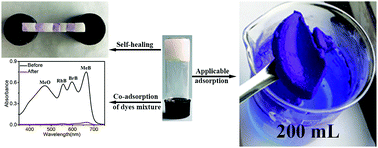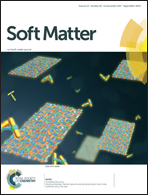An efficient supramolecular adsorbent for co-adsorption of dyes and metal ions from wastewater and its application in self-healing materials†
Abstract
Herein, a novel type of two-component supramolecular adsorbent, 2-OA, was developed based on non-covalent interactions using tetrazolyl derivative with octadecylamine (OA) and fully characterized using a number of structural and spectral techniques. The self-assembled 2-OA gels displayed remarkable stimuli-responsiveness as well as shape-persistent and self-healing properties. In addition, it was found that the adsorbent 2-OA was able to remove dyes (10 kinds of cationic and anionic dyes) and metal ions (Cu2+ and Fe2+) simultaneously from wastewater owing to synergistic electrostatic attraction, hydrogen-bonding, and hydrophobic and coordination interactions. It also exhibited excellent co-adsorption capability to dye mixtures and binary mixtures of dyes and metal ions. In particular, the dye/metal-loaded adsorbents could be obtained easily from the aqueous phase, and recycling of the adsorbents could thus be achieved. These results suggest that the supramolecular gel 2-OA not only has great potential application in wastewater treatment but also provides a strategy for the development of intriguing self-healing materials.



 Please wait while we load your content...
Please wait while we load your content...